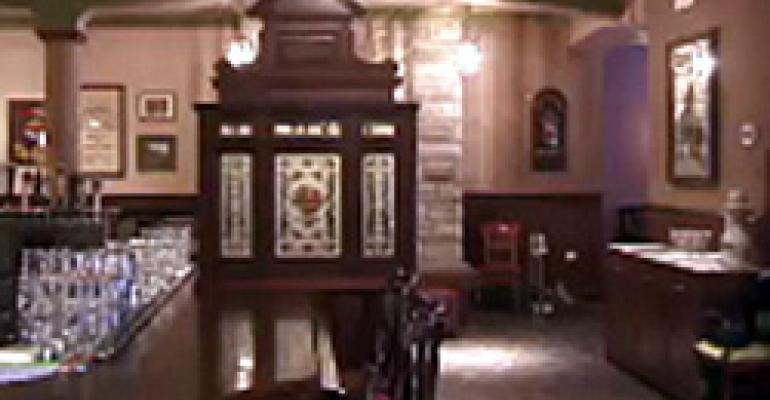Proving that Irish whiskey can be more than a St. Patrick's Day specialty, some bar and restaurant operators are enjoying year-round success with sippable single malts and signature cocktails and flavor infusions made with the smooth and distinctive spirit.
The Local is an Irish pub in Minneapolis that seeks new converts one sip at a time by touting seven Irish whiskeys, a signature Irish Coffee and a popular Irish-based highball called the Big Ginger.
"It's tough to walk into the Local and ask for Jack Daniel's and Coke and not be asked if you'd like to try Jameson," said general manager Josh Petzel. "We've made it our goal to covert the Scotch, Bourbon and Canadian drinkers. We say, 'Just try it — you can always go back to your usual.' "
Patrons can choose from offerings ranging from John Powers at $5.50 a shot to Midleton, an ultra-premium brand priced at $18. In the middle are three tiers of Jameson: the standard, at $6; the 12 year-old Jameson 1780, at $7.25; and the choice Jameson 18 year-old, $13. A house favorite is Redbreast ($8), an unusual pure pot still whiskey, a type distilled from a mixture of malted and unmalted barley that confers distinctive fruity nuances.
According to Petzel, the Local sold the most cases of Jameson of any establishment in the world last year — 353, to be exact. He attributes that success to consistent effort in training and merchandising plus a willingness to experiment with new applications of the spirit.
"We've made it very accessible by keeping price points modest," said Petzel. "We use it in our cooking when we can. And we do lots of staff education, particularly with the bartenders, because they stay longer than servers. So when someone has a question about Irish whiskey, there's always someone behind the bar who can answer it."
The Local's Irish Coffee is sweetened with a reduction of Guinness Stout and brown sugar. It's topped with whipped cream that is stiffened with vanilla pudding to keep it afloat longer. Lest it miss a sales opportunity, the menu offers a No Sweet Tooth dessert: "Our suggestion: Redbreast, the most popular of the Local family and perfectly enjoyed neat with a water back."
To boost Irish sales in the summer, the Local promotes the Big Ginger, a double Jameson and ginger ale in a tall16-ounce glass, priced at $5. Fresh lemon and lime garnishes add a dash of color unusual for whiskey drinks.
In addition, the bar also has made fruit infusions of Irish whiskey. One of the best was made with pears. "It was much sweeter than an ordinary whiskey, very easy sipping," noted Petzel.
At Mrs. Murphy and Sons Irish Bistro in Chicago, a house creation called The Whiskey features a shot of Bushmills, half as much simple syrup, a dash of bitters and a cherry. "It's a smoother, sweeter version of the Manhattan," said general manager Brian Murphy. His 13-item Irish collection includes single malts like Knappogue ($6) and Connemara ($7), the latter an unusual peated-malt Irish whiskey.
The Dupont Grille in Washington, D.C., shows the versatility of Irish in mixed drinks like the Dublin Handshake, which boasts a combination of Irish whiskey, Baileys Irish Cream liqueur and sloe gin, and Irish Eyes, made with Irish whiskey, green crème de menthe and cream. Each is priced at $8.
Top-flight Irish whiskeys fall in line with connoisseur spirits like single malt Scotch and small-batch Bourbon. Some partisans consider the taste of Irish smoother and more accessible to first-time consumers because it is distilled three times, as compared with twice for Scotch. In addition, because its malt is typically not dried over peat fires like Scotch, Irish whiskey doesn't taste smoky, making its unique flavors — including spicy and fruity nuances — more discernable.
Rising quality and vigorous promotion have made Irish the fastest-growing whiskey. Between 2005 and 2006, the Irish whiskey market in the United States grew 29 percent to $120 million in total revenues, double the growth rate of single malt Scotch, albeit from a smaller base, according to the Distilled Spirits Council of the United States, based in Washington, D.C. In 2003 total revenues amounted to $66 million. That's a big turnaround for a spirit that a century ago was a market leader in the States, only to be supplanted by cheaper and easier-to-drink blended Scotches. Today, with super-premium spirits a hot button, Irish distillers want to regain their share.
How successful has the Local been in its missionary work? "It's hit or miss," said Petzel. "Some people like the unique taste of Scotch. But I've converted. Irish is much smoother."

